 Pull-ups are a great muscle-building exercise. However, many of us struggle to even do one or enough reps to truly take advantage of the muscle-building rewards of this exercise. In this blog I explain why that is, tell you how to improve your pull-ups, and give you a full pull-up progression intended to take you from 0, 1, 2, 3… up to 10 pull-ups in a row or moreLet’s be honest, pull-ups are difficult. First off, whether you weigh 100 pounds or 350, that will be the weight you will have to overcome with each rep. Secondly, pull-ups engage more than just your back. You may or may not have a big back and bicep muscles but still can’t do more than one or two pull-ups. No matter how big the muscles in your back and biceps are, if you have weak links in the chain of movement, you will still be limited in your ability to do more pull-ups.
Pull-ups are a great muscle-building exercise. However, many of us struggle to even do one or enough reps to truly take advantage of the muscle-building rewards of this exercise. In this blog I explain why that is, tell you how to improve your pull-ups, and give you a full pull-up progression intended to take you from 0, 1, 2, 3… up to 10 pull-ups in a row or moreLet’s be honest, pull-ups are difficult. First off, whether you weigh 100 pounds or 350, that will be the weight you will have to overcome with each rep. Secondly, pull-ups engage more than just your back. You may or may not have a big back and bicep muscles but still can’t do more than one or two pull-ups. No matter how big the muscles in your back and biceps are, if you have weak links in the chain of movement, you will still be limited in your ability to do more pull-ups.
Change Your Training for Strength
The first step to improving your pull-ups is to change your training for strength improvements. Based on where you are at, I like to break it down into three groups:
- Group 1: 0–4 pull-ups
- Group 2: 5–7 pull-ups
- Group 3: 8, 9 and break through to 10
Group 1: 0–4 Pull-ups
If you are in the group 1 category, you currently can’t do a pull-up, or can’t do more than 4 in a row. You need to quickly build strength with a couple of exercises I like to do.
The first is inverted rows, which can be done under a bar in a rack or with the TRX Straps in the horizontal plane.
The second exercise is negative pull-ups to assist and train your body in a vertical plane. With negative pull-ups you will work on lowering (descending) for time, adding seconds to each rep as you progress. Make sure to fight the lowering in a full range of motion. Do not hold yourself in the up position and then just fall. Control the descent for the full range.
Group 2: 5–7 Pull-ups
Group 2 is further along and ready for pull-up progressions. This is when we will build up volume and work toward getting in 2–3 sets, with the goal of reaching toward 20–30 reps completed. We will add assisted pull-ups to allow for reducing the amount of resistance you need to overcome reps the higher volume. An easy way to do assisted pull-ups is to use a larger resistance band and loop it around the rack, giving you a platform to stand on while assisting your pull-ups.
Group 3: 8–10 Pull-ups
Group 3 is essentially going to repeat what group 2 is doing but adding weight to your pull-ups to help you break through to 10. Adding weight can be as easy as adding a weight belt with 5 pounds on it or putting a 5-pound dumbbell between your feet. When you are doing the banded assisted pull-ups, start to use smaller, thinner resistance bands to stand on.
All Groups: Work on Core, Scap Retractions
All three groups need to work on weak-link areas as well. First is core work; as I stated earlier, pull-ups are difficult and place concentrated demands on the core, also a known weak link. I like to use Planks and Hollow Rocks. Next, you need to work on scap retractions, and you can do small pulls to train it with scapular pull-ups and face pulls.
Shoulder Prehab
Start with prehab exercises. Prehab exercises should be used to bomb-proof your body and potentially prevent future injuries. The overall goal of prehab exercises is to increase durability in your physical activities with better-quality movements, which will improve performance and overall health. Here are two I like to start with. Pick one that works for you for today’s pull-up workout.
Option 1: Shoulder Prehab—Light Weights
x10 reps each
Standing: I, Y, T, W’s, Scap Taps
Lying: I, Y, T, W’s, Overhead Scap Taps
Option 2: Shoulder Prehab—Bands
x10 reps each
Standing: Band Pull-Aparts with Bent Elbows, Banded Figure 8's, Band Pull-aparts with Long Straight Arms
Banded Over & Backs
Half-Kneeling Lunge: Diagonal Pull-aparts with Long Straight Arms
The Pull-up Workouts
Now that you are warmed-up and have bomb-proofed your body, let’s begin the pull-up workout. Here’s the strategy to vastly improve your pull-ups. Reference your pull-up ability and progress accordingly from there. This is a full back workout performed once a week.
Group 1: 0–4 Pull-ups
Inverted Rows (under bar or TRX straps): 3–4 sets or 8–12 reps
Negative pull-ups: 3–5 sets or 3–5 reps ** FULL RANGE OF MOTION**
(Starting out 3x3 reps at 3s descents… progressing to 5x5 at 5s descents for each rep.)
Elbow or Push-up Plank: 3 sets of :30s–2mins
(Starting out with 3x sets at :30s… progressing to 2mins eventually)
Alternating your workouts with Scapular Pull-ups and Face Pulls: 3–4 sets or 8–12 reps with 2s holds
(Hanging from pull-up bar, squeeze scapular muscles, as if beginning the pull-up motion and hold for 2s for each rep. Next workout alternate with Face Pulls, keep elbows up and thumbs toward temples, again squeeze scapular muscle for 2s.)
Group 2: 5–7 Pull-ups
Pull-ups: Sets of 2–5 reps aim for 20–30 reps total.
Assisted Pull-ups w/larger resistance bands: Mirror how many sets/reps you accomplished with pull-ups previously. Shooting for the same.
Inverted Rows (under bar or TRX straps): 2–3 sets or 8–12 reps
Alternating your workouts with Elbow or Push-up Plank and Hollow Rocks: 3 Sets of :30s–2mins
Alternating your workouts with Scapular Pull-ups and Face Pulls: 2–3 sets or 10–15 reps with 2s holds
Group 3: 8–10+
Weighted Pull-ups: Sets of 2–5 reps, aim for 20–30 reps total.
(If you are just getting into group 3 and graduated up from group 2, start back over with reps and sets you began that group with; you are adding weight to your pull-ups now.)
Example, group 2
I started with 3x4 reps and progressed to 5x6 reps. Now do the same but with weight.
Assisted Pull-ups w/smaller resistance bands: Mirror how many sets/reps you accomplished with pull-ups previously. Shooting for the same +2 reps. Try to do a little bit more volume.
Inverted Rows (under bar or TRX straps): 2–3 sets or 8–12 reps
Alternating your workouts with Elbow or Push-up Plank and Hollow Rocks: 3 Sets of 1–2mins
Alternating your workouts with Scapular Pull-ups and Face Pulls: 3 Sets or 10–15 Reps with 2s holds
Use the Plan Once a Week
That’s it! Use the plan once a week to improve your pull-up potential. You will want to max out and test your pull-ups once a month to see if you are making progress and moving up groups to level up your strength gains.
As with any workout, to make gains, you must start somewhere, you must stay consistent, and you must work hard. Don’t be discouraged that you can’t do pull-ups yet. Stay the course and you will be blown away when you quickly increase your pull-up strength!
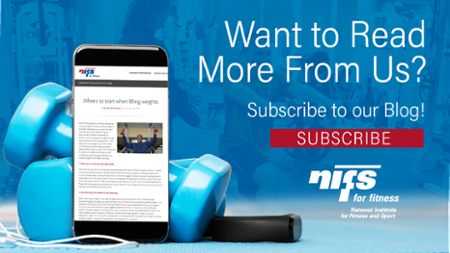
This blog was written by Michael Blume, MS, SCCC; Athletic Performance Coach. To learn more about the NIFS bloggers, click here.
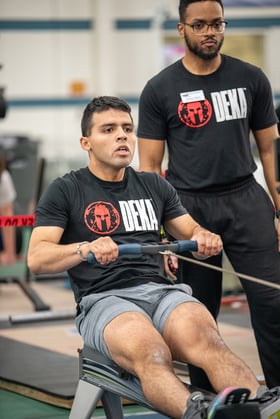 What Is the DEKA Challenge?
What Is the DEKA Challenge?
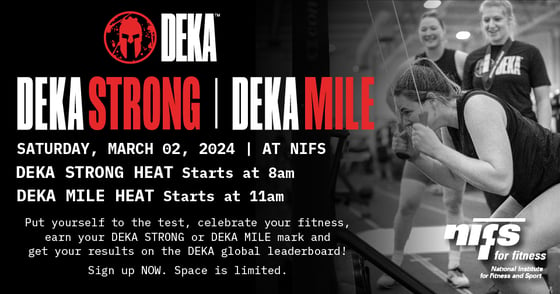
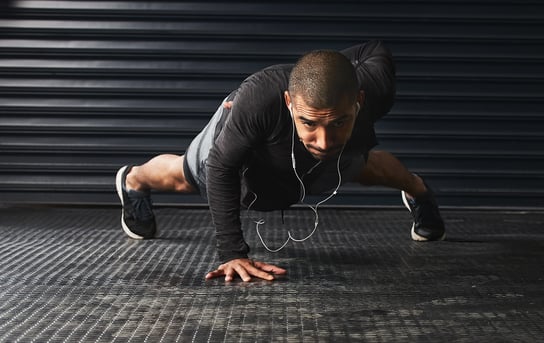 If you’re like me and absolutely love listening to music and discovering new artists, genres, etc., then I could bet that you most likely listen to music while you exercise. Combining music and workouts has become a common practice among fitness enthusiasts because it can provide a boost of motivation and energy for when you’re testing your one-rep max or just taking a brisk walk outdoors. However, in this blog I will discuss the potential drawbacks of listening to music during a workout/training session and, hopefully, it will make you think about how music (or no music) plays a role in your training.
If you’re like me and absolutely love listening to music and discovering new artists, genres, etc., then I could bet that you most likely listen to music while you exercise. Combining music and workouts has become a common practice among fitness enthusiasts because it can provide a boost of motivation and energy for when you’re testing your one-rep max or just taking a brisk walk outdoors. However, in this blog I will discuss the potential drawbacks of listening to music during a workout/training session and, hopefully, it will make you think about how music (or no music) plays a role in your training.
 If you’ve been into fitness for a while, you likely know how important it is to fuel and replenish your body before and after exercise with the proper nutrition. However, you might be uncertain and confused about why, when, and what to eat and drink to optimize your workouts.
If you’ve been into fitness for a while, you likely know how important it is to fuel and replenish your body before and after exercise with the proper nutrition. However, you might be uncertain and confused about why, when, and what to eat and drink to optimize your workouts. 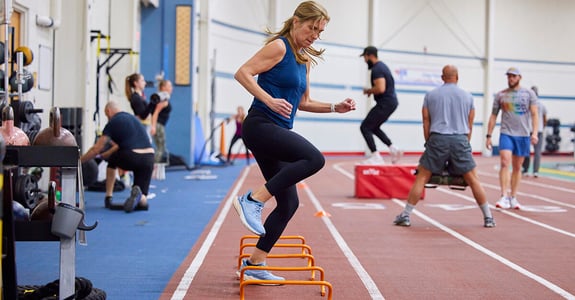 More and more in today’s society, people have one resource that seems like it is only getting stretched out thinner and thinner: time. Too many of us seem to be cramming more and more things into our lives, whether that be work-related events, personal interests, or family events. With this ever-growing list of things we have taking time out of our day, many have to choose between stuff they need to get done and things they want to get done. One thing we all know we should do but sometimes choose to skip because of time constraints is exercising.
More and more in today’s society, people have one resource that seems like it is only getting stretched out thinner and thinner: time. Too many of us seem to be cramming more and more things into our lives, whether that be work-related events, personal interests, or family events. With this ever-growing list of things we have taking time out of our day, many have to choose between stuff they need to get done and things they want to get done. One thing we all know we should do but sometimes choose to skip because of time constraints is exercising..jpg?width=532&height=342&name=GettyImages-1083005864(1).jpg) Muscle Mass Gains
Muscle Mass Gains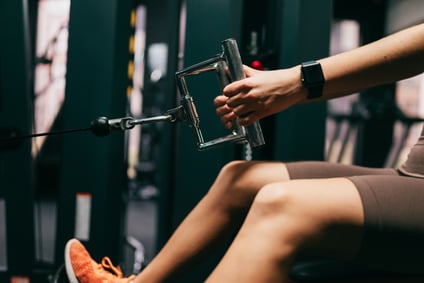 In this blog series, I have discussed
In this blog series, I have discussed  The holiday season is here. That means a lot of us will be traveling to see family and friends. You might be worried about not being able to keep up with your fitness routine while on the road. I am here to show you workouts that do not require a gym.
The holiday season is here. That means a lot of us will be traveling to see family and friends. You might be worried about not being able to keep up with your fitness routine while on the road. I am here to show you workouts that do not require a gym. 










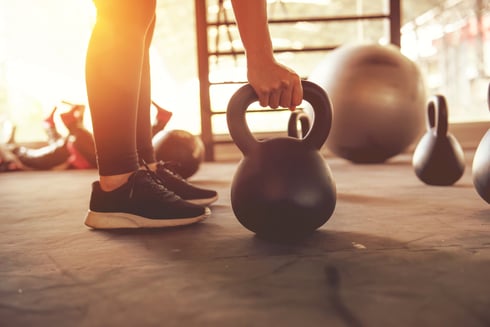 Trying to figure out the best time to work out can be a difficult decision when attempting to balance a healthy lifestyle with work, a social life, and other hobbies. Let’s look at the various benefits of working out at certain times of the day compared to others.
Trying to figure out the best time to work out can be a difficult decision when attempting to balance a healthy lifestyle with work, a social life, and other hobbies. Let’s look at the various benefits of working out at certain times of the day compared to others.  Pull-ups are a great muscle-building exercise. However, many of us struggle to even do one or enough reps to truly take advantage of the muscle-building rewards of this exercise. In this blog I explain why that is, tell you how to improve your pull-ups, and give you a full pull-up progression intended to take you from 0, 1, 2, 3… up to 10 pull-ups in a row or more
Pull-ups are a great muscle-building exercise. However, many of us struggle to even do one or enough reps to truly take advantage of the muscle-building rewards of this exercise. In this blog I explain why that is, tell you how to improve your pull-ups, and give you a full pull-up progression intended to take you from 0, 1, 2, 3… up to 10 pull-ups in a row or more